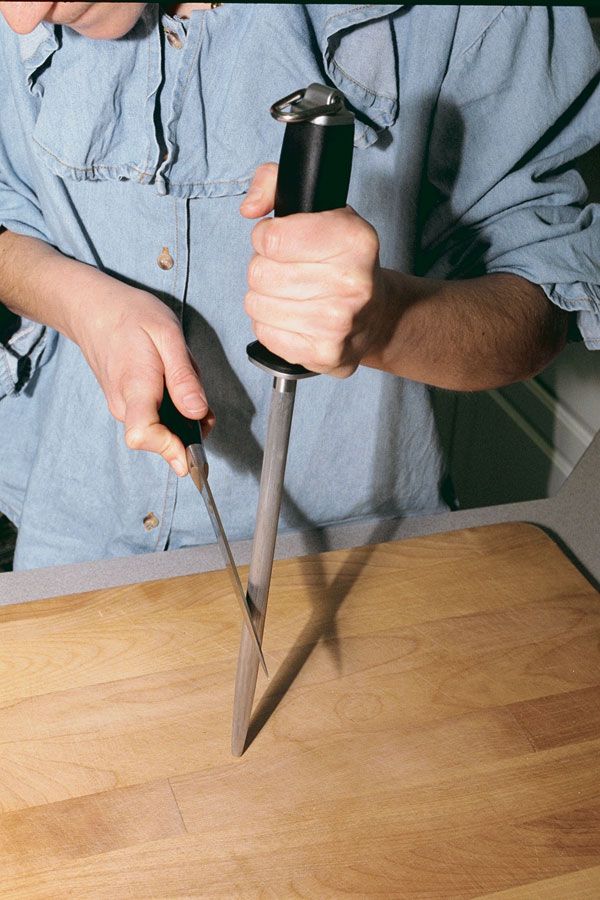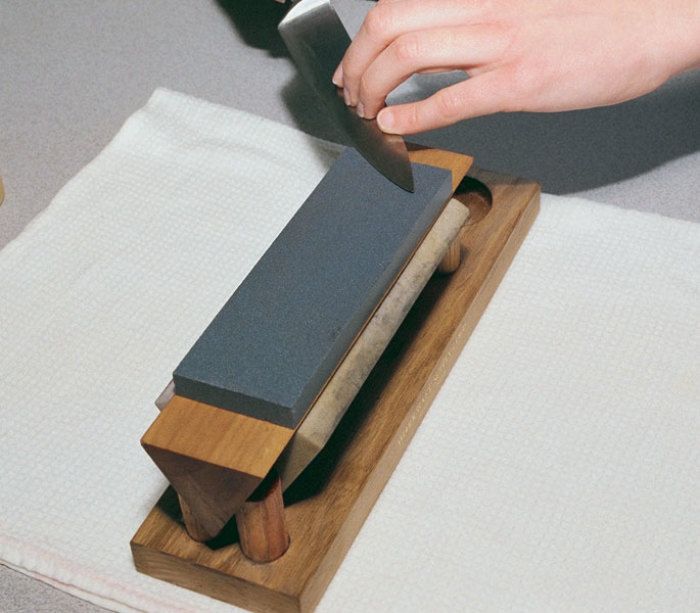
Ken Haedrich
June 1997
from issue #9
One of the most important rules of cooking is also the least observed: Keep your knives sharp. Why the lapse? I think many cooks simply don’t know how to keep their knives sharp. The requisite stones, steels, and gadgets appear both archaic and perplexing. And many knives can’t be sharpened easily by home cooks.
Let’s be clear that a sharp knife is infinitely safer than a dull one. Dull knives are unpredictable. They’ll graze off foods and take reckless turns, putting your digits in harm’s way.
Once upon a time, kitchen knives were made of either stainless steel or carbon steel. Stainless wouldn’t rust, but once it became dull, it was impossible to sharpen. Carbon steel, on the other hand, was softer and took a nice edge.
But carbon wouldn’t hold that edge, and it rusted like mad. Carbon also interacted with and tainted high-acid foods. Enter high-carbon stainless steel, an alloy that is both nonreactive and rust-proof, easy to sharpen, and able to hold an edge. Today, most high-end knives are made of high-carbon stainless steel.
The really dull part. Kitchen knives don’t typically become dull by cutting foods; they dull by repeated contact with a cutting surface. That’s why it matters what sort of cutting board you use. When a knife starts to dull, the blade begins to fold over on itself. This can be corrected with regular swipes on a honing steel, a procedure called “straightening out the burr.”
A honing steel should be a little longer than the blade of your largest knife and should have a protective guard, or hilt, at the base of the handle. While there’s more than one way to use a steel, the safest and simplest way is as follows: Hold the steel in front of you, vertically, with the point of the shaft resting on your cutting board. Hold the blade at a 20˚ angle to the shaft, applying only gentle pressure. Starting at the heel of the blade (the widest part closest to the knife handle), draw the entire cutting edge along the length of the shaft, while pulling the knife diagonally toward you. The stroke is complete when the knife tip crosses the shaft (see photo above). Repeat on the other side of the blade. Alternate strokes, five times on each side.
How often should you use a honing steel? I use mine two or three times daily because I put a lot of miles on my knives, but once a day is fine for most cooks. Keep your steel close by as a constant reminder.
Putting steel to stone. Even with regular honing, your knives will need to be sharpened often. Sharpening restores the edge by taking off old steel, traditionally by means of a whetstone. If you intend to take good care of your knives, it’s best to have coarse, medium, and fine stones.
If your blade is very dull, begin with a coarse stone, laying it down with the short edge facing you. Rub a few drops of mineral oil on the stone’s surface for lubrication.
With the knife held at a 20˚ angle to the stone, place the heel of the blade on the stone’s edge farthest away from you. Slowly draw the knife toward you until the tip passes over the stone. Steady the blade gently with the fingers of your other hand. Repeat five times.
Turn the knife over so the sharpened edge faces you and reposition the stone so the long edge faces you. Alternate the side of the blade every five strokes. Repeat this procedure using the medium and fine stones, decreasing the angle very slightly with each change. The entire process will take about five minutes.


















Comments
Log in or create an account to post a comment.
Sign up Log in